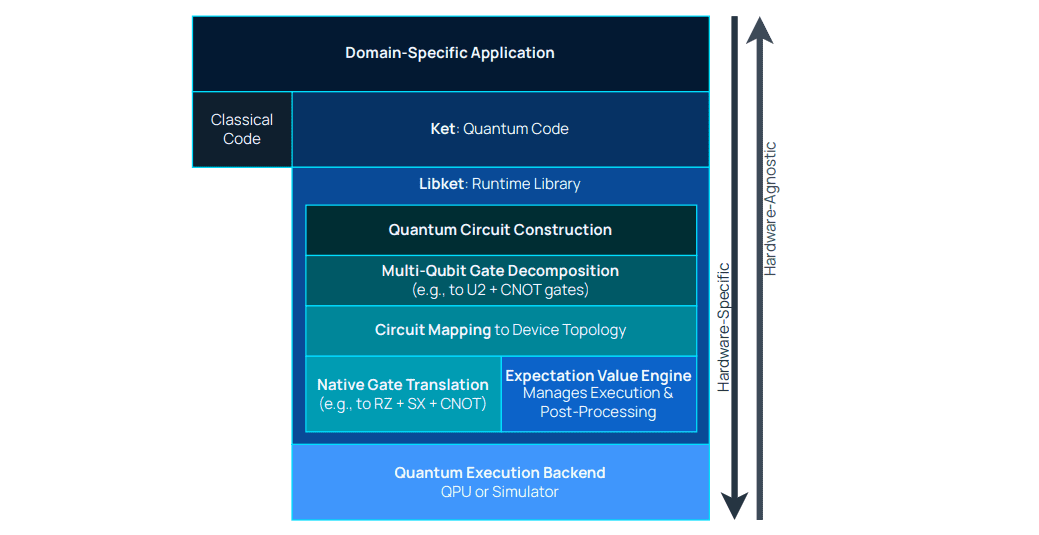The development of practical quantum computers demands more than just powerful hardware; it requires a complete software infrastructure capable of translating complex algorithms into precise physical control. Evandro Rosa, Eduardo Willwock Lussi, Jerusa Marchi, and Rafael de Santiago, all from Universidade Federal de Santa Catarina, address this challenge by presenting a full quantum stack, a comprehensive system that bridges the gap between abstract code and physical quantum processors. This work details each layer of the stack, from the user-friendly Ket programming platform to the calibrated microwave pulses that manipulate quantum bits, offering a blueprint for managing complexity and optimising performance. By demonstrating a complete workflow, including the compilation of a Grover diffusion operator, the team establishes a framework for building practical and performant quantum applications and illuminates the crucial interplay between software and hardware.
Quantum Background
A complete quantum software stack, Ket, facilitates the development and execution of quantum programs, addressing the growing need for robust software infrastructure as quantum computing hardware scales. Ket encompasses a quantum intermediate representation (QIR), a compiler, and a runtime system, all tailored for near-term quantum devices. This design prioritises flexibility, allowing targeting of diverse quantum architectures and incorporation of custom optimisation strategies. The core of Ket is its QIR, which provides a machine-independent representation of quantum circuits, enabling platform-specific optimisations without modifying the original quantum algorithm.
The compiler translates high-level quantum programs into the QIR, then maps this onto the specific instruction set of the target quantum hardware. This modular approach allows easy integration of new quantum devices and exploration of different compilation techniques. A key contribution is the development of a runtime system that manages the execution of quantum programs on real hardware, handling resource allocation, error mitigation, and data transfer between classical and quantum processors. It also provides tools for monitoring execution and diagnosing performance bottlenecks, supporting both gate-based and measurement-based quantum computing paradigms. The results demonstrate that Ket achieves competitive performance compared to existing quantum software stacks, while offering greater flexibility and scalability. This platform facilitates the development and deployment of quantum applications on near-term quantum hardware, paving the way for practical quantum computation.
Full-Stack Quantum Software Compilation and Platform Development
Scientists engineered a comprehensive quantum software stack, bridging the gap between high-level algorithm development and low-level physical control of quantum hardware. This pioneering full-stack approach, analogous to classical computing, manages complexity and enables hardware-agnostic programming. Researchers developed the Ket quantum programming platform, providing an expressive, Python-based interface for algorithm creation, leveraging Rust for computationally intensive tasks. The compilation process translates hardware-agnostic programs into hardware-compliant circuits through a multi-stage procedure involving gate decomposition, mapping to respect device connectivity, and native gate translation.
To demonstrate this workflow, scientists compiled the Grover diffusion operator for a specific quantum processor, then connected the compiled circuit to its physical realization by implementing native gates through calibrated microwave pulses. Precise calibration of both single- and two-qubit gates was achieved, alongside detailed frequency characterization and measurement procedures. Researchers implemented two distinct execution modes, batch and live, to manage the interaction between classical and quantum processors. Batch mode optimises resource usage, while live execution enables dynamic control. The study utilises a ‘Process’ class to manage the quantum execution context, encapsulating information like qubit availability and the target’s native gate set. Scientists also developed a built-in quantum simulator, KBW, allowing users to simulate small-scale quantum programs on personal computers, compatible with Linux, Windows, and macOS operating systems.
Full-Stack Quantum Software Platform Demonstrated
Scientists have developed a comprehensive, end-to-end quantum software stack, bridging the gap between high-level algorithm development and the physical control of quantum hardware. The core of the system is the Ket platform, built upon a high-performance runtime library written in Rust, and a Python programming interface, offering an expressive environment for quantum software development. Researchers also integrated the Ket Bitwise Simulator (KBW), a noiseless simulator allowing execution of quantum applications on conventional hardware. The team implemented a classical-quantum model, enabling the construction of hybrid programs that leverage both classical and quantum computational resources.
The platform is compatible with Python 3. 10 or newer, and is available for Linux, Windows, and macOS, installed via pip. This layered architecture facilitates integration of new solutions and optimizations, as modifications typically require interaction only with immediately adjacent layers. Experiments demonstrate the complete workflow by compiling the Grover diffusion operator for a quantum processor. The compilation process translates hardware-agnostic programs into hardware-compliant circuits, handling gate decomposition, respecting device connectivity, and translating to native gates. Researchers detailed the calibration of single- and two-qubit gates, including frequency characterization and measurement procedures, illustrating how abstract quantum programs map onto the physical control of qubits through calibrated microwave pulses.
Code to Control, Quantum Hardware Realised
This work presents a comprehensive, end-to-end quantum software stack, detailing the complete process from high-level algorithm development to physical execution on quantum hardware. Researchers successfully demonstrated a multi-stage compilation process that translates abstract quantum programs into hardware-compliant circuits, addressing crucial steps like gate decomposition, device connectivity mapping, and native gate translation, exemplified by compiling the Grover diffusion operator. The team further connected this compiled circuit to physical realization by detailing the calibration of microwave pulses used to implement single- and two-qubit gates, providing a clear pathway from code to physical control. This achievement establishes a framework for developing practical and performant quantum applications by illuminating the critical interplay between software abstraction and underlying hardware. While acknowledging the complexity of current quantum systems, the authors highlight the importance of a full-stack approach for managing this complexity and enabling scalable quantum computation. Future work will likely focus on optimizing these processes and improving the fidelity of quantum operations, ultimately contributing to the development of more robust and reliable quantum computers.

